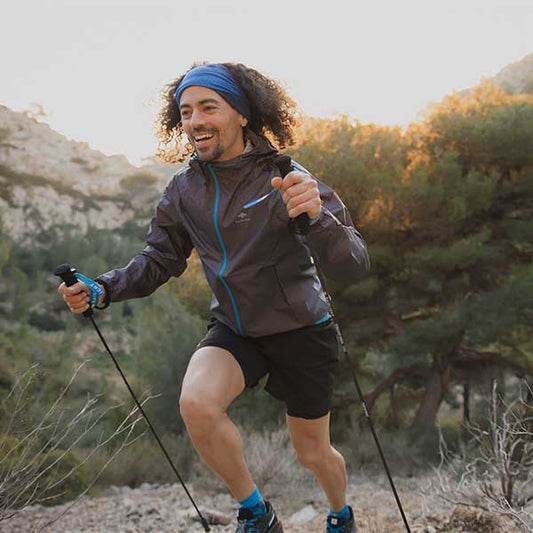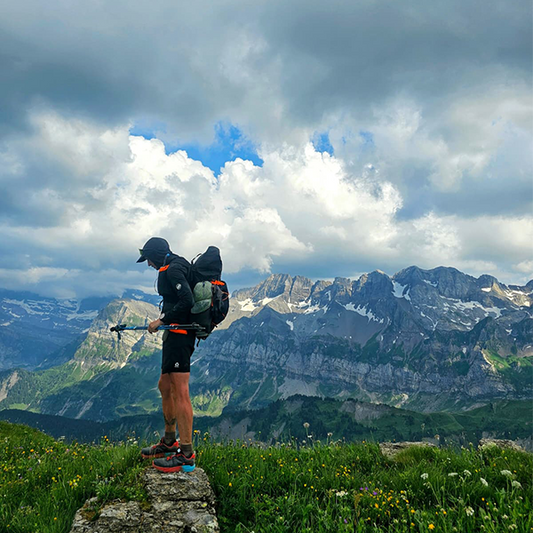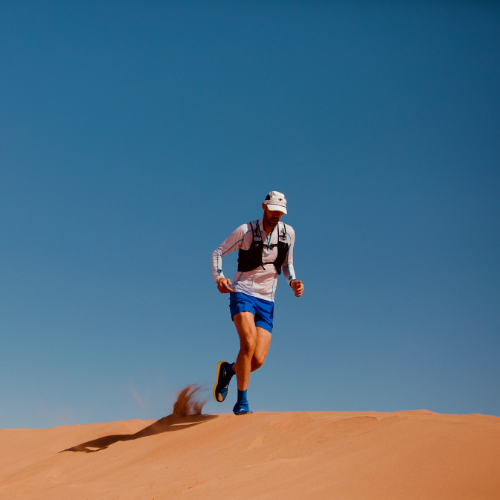Benoît Laval is a textile engineer with a passion for mountains and running, which he has been doing competitively since the age of 10. He built his life around his passions by founding Raidlight in 1999 and taking over the travel agency NED - Trail To Be Alive, which specialises in sports trips, trails and stage hikes abroad.
His sporting achievements have grown alongside his activities: 2nd in the Grand Raid de la Réunion in 2003, 9th in the Marathon des Sables in 2004, French Trail Team in 2010, Ultra-Trail 400km de Gobi in 2015, Barkley in 2016...
TOPIC 1: TRAINING
Hi Benoît, the Raidlight Desert Trophy race is fast approaching, so we're here to provide as much advice as possible to future participants in this event. First of all, when do you recommend starting specific preparation for this race and what are the prerequisites?
In general, this type of desert race is a continuation of several years' experience, and you have to rely above all on your years of experience.
But we're also organising this race so that it's accessible, with a route that's not too difficult, and by providing almost all the logistics, including meals, tents and mattresses. So we're offering 2 routes: one of 160km in 4 days for experienced runners, and the other of 100km in 4 days, which is easier and open to runners and walkers. From a specific training point of view, 2 to 3 months is a good length of preparation.
Training depends on the level of the runner as well as their objective, but what volume of training (weekly) would you recommend for someone aiming to finish this race?
One of the first risks is changing your habits too much, increasing the volume too much... and injuring yourself before the race. The other risk is training too hard with a backpack that's too heavy... and injuring yourself.
In my opinion, you need to prepare with a "marathon" type training plan. In other words, you need to do some endurance training, as well as work at different, faster paces. In general, you need at least 3 sessions a week.
This race in Jordan will be run over different types of terrain (sand, rock), so which is best to train for (trail, road, mountain, etc.)?
A lot of trail runners are attracted by desert races. After the mountains, it's like a continuation of a trail runner's quest for scenery and self-knowledge. However, these races are in the very rolling category.
In the Raidlight Desert Trophy, there are around 500 metres of ascent on the 30km or 60km stages, simply long false flats and a few small canyons to cross. You'll need to combine the regular pace of a marathon runner with the off-road experience of a trailer rider, so you can vary your pace to suit the terrain and carry your rucksack.
Recovery phases are also essential. What advice do you have for maximising this process? (Accessories, rituals etc.)
Recovery is an integral part of the training process, and you generally need to plan a week of relaxation every 3 or 4 weeks. But you should also listen to your body and skip a few sessions if you're too tired. What's important is to feel a progression week after week, to feel that your physical condition and pace are increasing with each session.
SUBJECT 2: EQUIPMENT
In a second blog post, we have already drawn up a list of the equipment you need for this race, but perhaps you have something to add?
One fundamental point is to set off LIGHT. There's the compulsory gear, and then almost nothing else. For 4 days in the desert, you have to choose to take the minimum. A change of swimming costume, a change of socks, a change of underwear, a windproof jacket and trousers, a small fleece and that's it.
The lightness of the bag is about performance, but above all it's about racing comfort with less weight, and intellectual comfort with a few days of extreme simplicity.
In the equipment list we presented the Revolutiv 24-30L, Endurance 10-20 and Raid Legend 24L bags. Which one is your favourite and why?
Based on my experience, I'd definitely take the Revolutiv 24-30, because it's the simplest and lightest. The Legend 24 offers a little more comfort with a back and shoulder straps with more foam, as well as more pockets to keep everything in its place. It's been our best-seller for the last fifteen years.
The Endurance 10-20 is a hybrid rucksack with a zip that allows it to be converted from 10 to 20 litres. It's the most versatile and the one I use most often for training in the mountains and on reconnaissance trips for new events.
What advice do you have about managing nutrition on race days? (Unlike other desert races, all meals and refreshments are provided by the organisers).
Hydration is the most important thing. Depending on your body type and temperature, you should drink between ½ litre and 1 litre per hour. And above all, take the few seconds at the refreshment posts to drink plenty on the spot, as what you drink on the spot you don't have to carry with you afterwards.
For the stages, at the Raidlight Desert Trophy there will be simple refreshment points with oranges, bananas, dried savoury cakes, dried grapes, cola and water.
For the first two stages, which are not too long, eating is a bit superfluous. For the last two stages, bananas, oranges and cola will be more necessary.
If you want to be a bit more considerate, taking 5 or 6 bars or gels with you for the last two days could complete the panoply in case you feel a bit peckish. But overall, the fact that meals and basic supplies are provided should mean that you won't have to worry too much about nutrition for the Raidlight Desert Trophy.
Blisters are often a runner's nightmare, especially when the terrain contains sand. Do you have any tips on how to avoid them?
Blisters in desert races are caused by a combination of factors: the heat, the backpack and the sand.
When it comes to sand, it's essential to use desert mini gaiters (which cover the whole shoe) to ensure that there's no sand in the shoe. You should have the Velcro sewn on by a shoemaker, as this is much more effective than gluing it on and running the risk of it coming unstuck.
A rucksack weighing between 4 and 6 kilos alters your stride and support. You need to train with it once a week in running condition. And there are products on the market for tanning your feet, which strengthens the skin and is fairly effective, in a cycle of about 1 month before the race.
Have you come across any unforeseen events during your shopping trips, and what would you recommend to anticipate them?
Fortunately, there are a lot of unforeseen events in races, otherwise it wouldn't be much fun. Not everything is planned in the same way as a marathon. You have to be philosophical, calm and adaptable.
The most important points for me are
1. always know roughly where you're going, memorise the topo, anticipate the route and the gradients
2. always have a small repair kit (thread, needle, shoelace, pins)
3. Always have a small mental repair kit with sweets and sausages.
ORGANISATION / BIVOUAC
It's clearly stated that the race is "all inclusive", so all travel, accommodation and meals are included in the price of the race number. Can you sum up the event in a few words?
There are two days of sightseeing: the first day with a visit to Petra, and the last day with fanning your feet on the beach at the Red Sea. And in the middle, 4 days of racing with 4 bivouacs. We'll arrive at the bivouac in the evening after Petra, spend the night in tents, and the next morning we'll be given our number bibs, with runners leaving their suitcases behind and keeping only their rucksacks.
Then 4 stages to run, with buffet lunch at the finish, followed by dinner and a night in the tents. After the 4th stage, the buses will be waiting for us, and we'll go to the hotel in Aqaba on the Red Sea.
Life on the bivouac is organised in Berber tents for several people. What are the things you need to know and the equipment you shouldn't forget?
The bivouacs will change place every evening to see more of the landscape. The tents are large Bedouin tents, for 12 to 15 people, open on 3 sides. We provide fairly comfortable 4-5cm thick mattresses. Meals will be taken in the organisation's large tents, prepared locally by the Bedouins. There will be toilets and a water tank for basic washing.
With this type of locally-coloured bivouac, we hope to create a friendly and typical atmosphere, so that you really feel you're in the desert.










